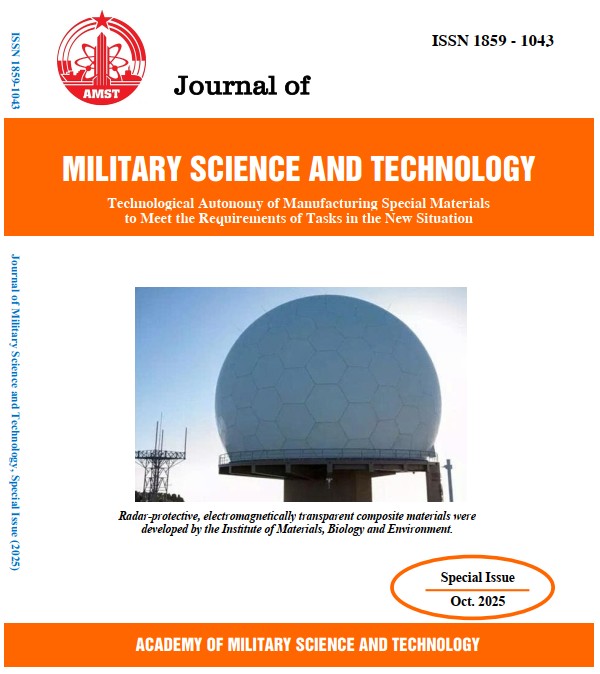Advanced nanocomposite Bi2WO6@graphene oxide special material: Optical properties and photocatalytic activity for degradation of phenol red
DOI:
https://doi.org/10.54939/1859-1043.j.mst.IMBE.2025.102-107Keywords:
Bi2WO6@x%GO; Nanocomposite; Optical; Photocatalytic; Phenol red.Abstract
In this paper, the photofluorescence emission, energy reflection and diffusion properties, band gap energy, surface charge distribution and magnetic properties of Bi2WO6@(0-5)%GO nanoparticles have been further studied. The photoluminescence (PL) spectrum of Bi2WO6@(0-5)%GO nanoparticles has strong emission in the blue-red light region (450-713 nm), in which the peaks at 468 and 569 nm correspond to the energy shift in the oxygen vacancy state of Bi2WO6. The emission intensity of Bi2WO6@5%GO in the 435-525 nm region is lower than that of Bi2WO6, which reduces the recombination rate of electrons and holes in the Bi2WO6@5%GO hybrid nanocomposite. GO enhanced the energy absorption capacity of Bi2WO6@5%GO in the visible region, and the band gap of Bi2WO6@(0-5)%GO nanoparticles was in the range of 2.76 - 2.88 eV. Both GO and Bi2WO6@(0-5)%GO nanoparticles had negative surface charges ranging from -21.697 mV to -9.124 mV and had small magnetism. The chemical adsorption of phenol red (PR) on the surface of Bi2WO6@(0-5)%GO nanoparticles was from 22.25% to 31.96%, following the second-order adsorption kinetic model with a correlation coefficient R2 of about (0.971–0.992). In particular, Bi2WO6@(0-5)%GO nanoparticles had good photocatalytic activity, the photodegradation efficiency of PR reached 64.89% - 86.04% under visible light illumination in 210 min. The PR photolysis reaction followed the first-order reaction kinetic model, in which the Bi2WO6@5%GO nanocomposite exhibited high photocatalytic activity, with the photolysis reaction rate constant 1.83 times larger than that of the original nano Bi2WO6. Based on its outstanding properties, nanocomposite Bi2WO6@(0-5)%GO has potential applications in the treatment of color indicators/dyes in chemistry and food technology, in the textile industry and in the fields of semiconductor technology, electrical engineering, electronics, luminescence, automation and green chemistry.
References
[1]. A. Elaouni et al., “Bismuth tungstate Bi2WO6: a review on structural, photophysical and photocatalytic properties”. RSC Adv, Vol. 13, pp.17476–17494, (2023).
[2]. C. Chen, et al., “Adsorption, photocatalytic and sunlight-driven antibacterial activity of Bi2WO6/graphene oxide nanoflakes”. Vacuum, Vol. 116, pp. 48-53, (2015).
[3]. C. Sun, et al., “Sol-gel synthesis of Bi2WO6/graphene thin films with enhanced photocatalytic performance for nitric monoxide oxidation under visible light irradiation”. Chemical Physics Letters, Vol. 702, No.2, pp. 49–56, (2018).
[4]. Hadi Salari, “Facile synthesis of new Z-scheme Bi2WO6/Bi2MoO6 p–n junction photocatalysts with high photocatalytic activity: Structure, kinetics and mechanism approach”. Materials Research Bulletin, Vol. 131, pp.110979, (2020).
[5]. H. Ma, et al., “Significant enhanced performance for Rhodamine B, phenol and Cr(VI) removal by Bi2WO6 nanocomposites via reduced graphene oxide modification”. Applied Catalysis B: Environmental, Vol. 121–122, pp.198–205, (2012).
[6]. J. Xu, et al., “A simple method for the preparation of Bi2WO6-reduced graphene oxide with enhanced photocatalytic activity under visible light irradiation”. Materials Letters, Vol. 92, pp.126–128, (2013).
[7]. L. Ji, et al., “Enhanced visible-light-induced photocatalytic disinfection of Escherichia coli by ternary Bi2WO6/TiO2/reduced graphene oxide composite materials: Insight into the underlying mechanism”. Advanced Powder Technology, Vol. 31, pp.128–138, (2020).
[8]. Q. Ma, et al., “Visible light active graphene oxide modified Ag/Ag2O/BiPO4/Bi2WO6 for photocatalytic removal of organic pollutants and bacteria in wastewater”. Chemosphere, Vol. 306, pp.35512, (2022).
[9]. Z. Li, et al., “Enhanced Photocatalytic Activity of Hierarchical Bi2WO6 Microballs by Modification with Noble Metals”. Catalysts, Vol. 12, pp.130, (2022).
[10]. Z. Mengting, et al., “2D Graphene oxide (GO) doped p-n type BiOI/Bi2WO6 as a novel composite for photodegradation of bisphenol A (BPA) in aqueous solutions under UV-vis irradiation”. Materials Science & Engineering, Vol. 108, pp.110420, (2020).
[11]. O. Rojviroon et al., “Enhanced photocatalytic activity of Bi2WO6/gC3N4 nanocomposite in degradation of methylene blue and for energy storage applications”. J. of Molecular Liquids, Vol. 436, 128224 (2025).
[12]. Chu Manh Nhuong et al., “Thin layer nanocomposite Bi2WO6@graphene oxide: unique properties of materials”. Journal of Analytical Sciences, Vol. 31(2A), pp. 61–68, (2025).







